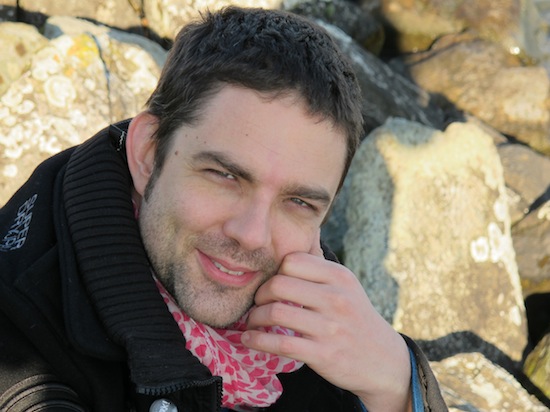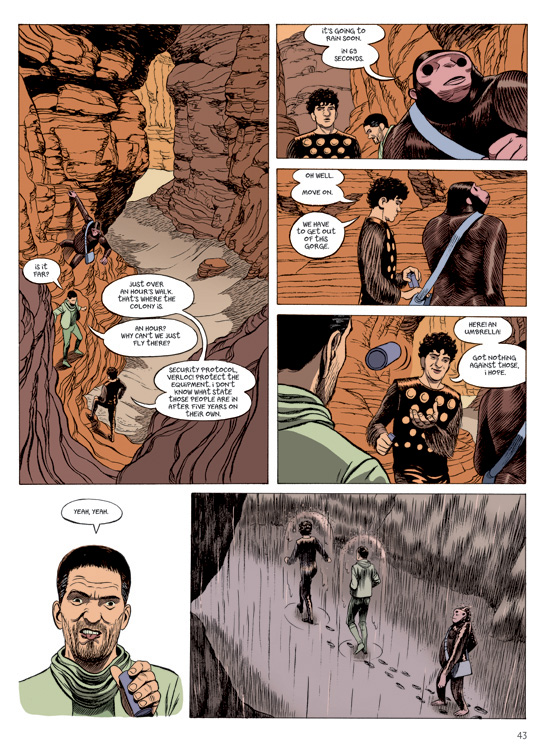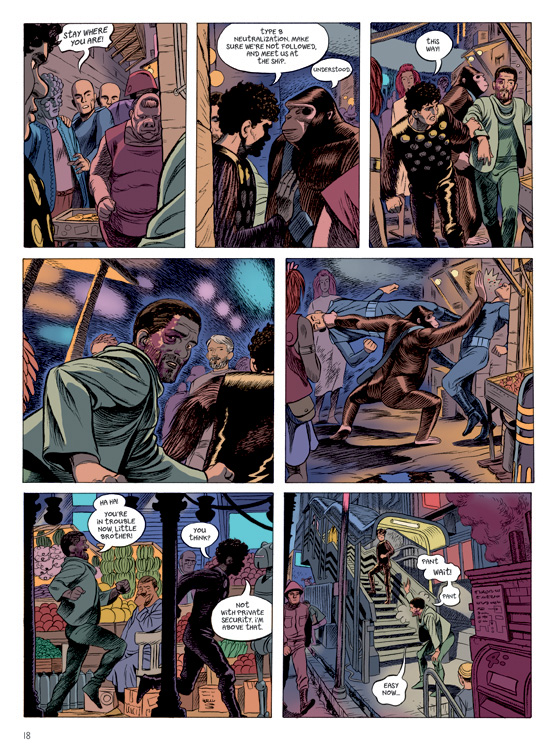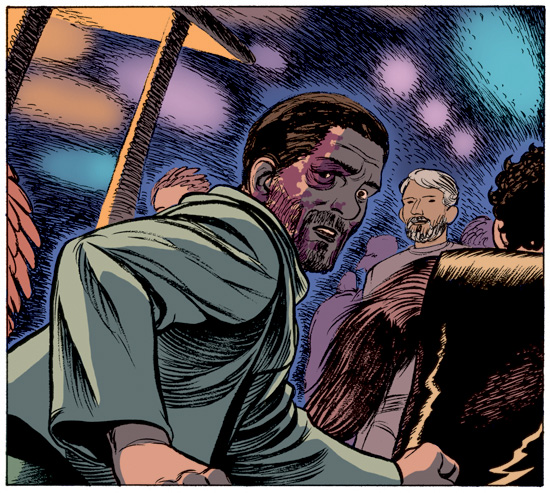Beginning with 2001’s Blue Pills, Frederik Peeters has consistently put out intriguing and beautiful work. Blue Pills tells the story of his courtship of Cati who, along with her young son, tests positive for HIV. Peeters poetically depicts their relationship and life in Switzerland, often with humour, as they learn to live with this ‘rhino in the room’ (literally seen as such in some panels). The two are now married and have a young daughter. As we discuss below, Peeters was shocked that, with all the international attention he received from the book, he was considered an optimist.
Of his works translated into English, two collaborations followed. Koma with the script by Pierre Wazem, and Sandcastle, written especially for Peeters by Pierre Oscar Lévy. Koma centres on Addidas, a young girl who, while helping her father clean chimneys, is prone to black outs. She enters a subterranean world where creatures control machines linked to each individual human above. There Addidas befriends the so-called monster that operates her own personal machine and brings him up to the world. At first glance this is a children’s book but as one reads on it gets quite dark, complex, and surreal. In Sandcastle, Peeters does an excellent job of illustrating Levy’s tale of claustrophobic terror. This David Lynchian tale begins with the discovery of a dead body at the beach and grows more and more tense as the 13 holidaymakers realise what is happening but all efforts to escape or call for help are thwarted by unseen forces. Sandcastle won Best Science Fiction Graphic Novel of 2011 at the Utopiales Science Fiction Festival.
Next came Pachyderme, one of the best books I’ve read in ages. Seriously, if you don’t know it, stop reading this and go pick up Pachyderme right now. A gorgeous surreal journey through the placental boundaries of the psyche, oscillating between alluring purples and spectral greens. Set in Romandie in 1951, Carice abandons her car in a traffic jam (caused by a dead elephant in the road) and hikes to the hospital where her husband has been taken after a car crash. Once there, the bodies in the morgue can still speak, a female piano student love interest of hers shows up, babies keep appearing (walking, waving, tumbling), nipples grow out of a wall, a giant flowery vagina materialises as an exit into the forest, and Carice finally finds herself in the arms of a genius surgeon with deep secrets and a heavy drinking problem. Along with the deep self-excavation, Pachyderme is also a wonderful tale of love and international espionage.
In November 2013, SelfMadeHero (who also released Sandcastle and Pachyderme) put out the first part of Aama, currently at volume three in the original French. Below Peeters tells how the sight of a children’s toy blossomed into a sci-fi exploration of the emotions. The book opens on Verloc lying face down on desert planet Ona(ji), trying to remember who he is. Soon Churchill, a robotic ape man bodyguard, appears and hands Verloc his diary. As the two make their way back to the colony, Verloc attempts to piece together what has happened in the seven days since they left their distant home of Radiant with Verloc’s rich brother, Conrad. Conrad has been sent to check on a scientific expedition that was abandoned years ago. Destitute, having lost his dead father’s business, estranged from his wife and forbidden to see his daughter, Verloc goes along for the ride. Once they arrive, the scientific community is splintered, dysfunctional, and the target of small attacks from sources unknown. The inner turmoil of the characters is brilliantly reflected in the contrasting landscapes and habitats of each planet – the bustling chaos of Radiant, still recovering from ‘The Great Crisis’, and the barren danger of Ona(ji), which may prove the breeding ground for a revolutionary technology. Biorobotics firms, genetic modifications and manipulations, ethical choices in the face of these big businesses, family dynamics, and sexual politics all play a role in this engrossing tale.

Aama is quite a departure from books like Pachyderme and Blue Pills. Tell me about your interest in science fiction.
Frederik Peeters: It’s been a long time now. About eight years ago, right after Blue Pills, I had a series called Lupus and that was science fiction. After Blue Pills everybody was talking to me about the optimist aspect of the story and how I was always positive. And I was thinking ‘This is not me. This doesn’t sound like me’, I must try to work on the dark feelings a little bit more. Like solitude and loneliness and maybe the general unease of the modern Occidental male (laughs). I wanted to create characters and get them lost in space and see what happens. So for Aama I asked myself what genre I preferred, what I was most comfortable working in, and it was science fiction. Because of the freedom it allows.
I have to preface something. I don’t write scripts. I don’t write scenarios before working. I don’t separate the two things. So I write at the same time as I draw. When you have that in mind, science fiction is the best way for me to work because it allows a lot of strange images and experiments.
So that dream sequence at the beginning of Aama – dream sequences usually point to something in the future – when you wrote that, did you have anything in mind as part of the whole? Or did that just come to you?
FP: It doesn’t work that way. It’s not built in advance. It’s more a game of echoes. I play with accidents and real dreams and then I try to use those to feed the story. It’s quite the opposite, in fact.
So dreams play a big part in your work. Pachyderme to me reads like a dream.
FP: Yeah, of course. Moebius once said in an interview that science fiction is the best genre if you want to draw the inner landscapes of the characters. So for me science fiction is like a journey which is also mixed with visions and dreams.
Moebius wrote the intro to Pachyderme. Are you a big fan of his work?
FP: I’m a huge fan of Moebius. He’s one of the three main artists that influenced me. His work in the 70s is what’s most interesting to me, the experimental part. It’s the way he mixed nightmares, drug experiments, and tried to draw what’s happening deep inside him. He might be the greatest comic artist ever (laughs) but it’s more the way he worked in the 70s that inspired me.
Who are your other influences?
FP: I grew up with Hergé and Tintin. It’s very difficult to say which is my favourite story but probably Tintin in Tibet. I have a strong feeling for Coke en Stock (The Red Sea Sharks) too. It was very disturbing to me when I was young. This story of modern slaves and everything. And also L’Affaire Tournesol (The Calculus Affair) because a part of it happens in Switzerland.
Tintin in Tibet is filled with white. One of the things I loved about Sandcastle was the use of white space. I thought those huge, unsettling expanses really reinforced the claustrophobia that was contained in them. Was that in the script or was that your own invention?
FP: It was my choice. My first decision was to make it in black and white because it’s the opposite of the classic narrative pattern where characters never change and the background changes all the time. Here the background is always the same and the characters are changing. So it was pointless to use colour for this story.
You’ve stated that you prefer to work on your own stuff but I was wondering what drew you to taking on scripts like Sandcastle and Koma.
FP: It’s like holidays. It’s different because it’s always with close friends. Pierre Wazem and Pierre Oscar Levy are friends. It’s not scripts coming from the outside.
The skin carving scene in Koma particularly struck me. Was that difficult to draw – extended peeling of the skin?
FP: It was unexpected but no, it was okay. It wasn’t disturbing to me, but maybe for the story because at that point I thought I was drawing a kids’ story. And suddenly it became more like a nightmare but I like this. I like when it’s not formulaic, when you’re surprised by the story. I think this sequence is an homage to the Japanese writer Murakami. There is a big peeling sequence in the middle of The Wind-Up Bird Chronicle. I think Pierre Wazem read this book while writing the scenario and he wanted to put something like this in it (laughs).

What is RG that’s mentioned on your website?
FP: RG is again a collaboration. With a French policeman working in Paris. RG is Renseignements Généraux, it’s a little bit like the FBI. An editor and publisher wanted to provoke a meeting between this very strong big mouth policeman and the shy Swiss comic artist (laughs) and see what happens. So I had a few interviews with him and picked up a lot of little stories, details, and then I wrote a scenario. It’s a bit like a French thriller, if you want, or film noir, but very realistic.
Anything like Tardi’s work?
FP: But more modern. Because with Tardi, it’s always in the past, the dark Paris of the past. This is very modern, it’s about the terrorist affairs and again modern slaves, people traffic, etc.
I read your interview with Paul Gravett the other day and you were saying you hadn’t done any autobiography since Blue Pills but do you see any bits of yourself in Aama?
FP: Yeah, of course. Because I’m trying to work on the very intimate emotions, what happens in everyday life and the relationship I have with my family, wife, my young daughter. This is the base of my work, the emotional part. And then I put on this more classic adventure scenario and some science fiction questions, if you will. So the story with the kid and the wife in Aama is again fed by my own experience. Also all the big questions of the book, the relationship we have with our own technology and communication technology and all those great questions are my intimate questions.
The portrayal of the sex scene at the end of Part One between Verloc and Mya, that reminded me of the scene in Blue Pills where you’re talking with Cati about what she brings out of you. Is that just a coincidence?
FP: (thinks) I think it’s a coincidence. Probably. Because in one case it’s my story with my wife and the other one, it’s just a secondary character. I wanted to work with…infidelity. You will see in the rest of the story, she also has a story with another guy and I wanted to work around this, all those strange feelings, jealousy, etc.
Was there any real life incident behind Verloc being screwed over by Parjapath?
FP: (laughs heartily) Why the question? You have a feeling for this? That’s funny. Because before I started to work on Aama, I wanted to take a few days to think over and build the story in my head and make notes, etc. So I spent 10 days in Cairo, Egypt. Just to…wash my head, if you want (laughs). And I met a guy a little bit like this and he swindled me, but only for something like £10, so it was totally harmless. But I found very interesting the feeling of being used and betrayed, you know? It’s very humiliating. So like most of those side stories in Aama, most of the time it’s real events but it didn’t happen like that exactly. I transform it. I just use the core, the strong feeling.
How was the rest of your trip to Cairo?
FP: It was great. It was crazy. I chose Cairo because I wanted something not too far away from Europe. I didn’t want to fly for 20 hours. Also, because it is one of the most ancient cities on the planet, it was interesting to go there to write science fiction. It’s also a place where the religious feeling is very powerful. Religion is everywhere – in people, in the streets, and of course in the landscape and the buildings. So it was very, very different from my home. And also very inspiring.
You were saying before your three big formative influences were Moebius, Hergé, and who would be the third?
FP: It would be probably Otomo or more precisely, the classic Manga from the 80s and 90s. But you can add to this the underground American scene, with people like Crumb, and Joe Matt and Matthew Kelly in the 90s. So those are the four main poles.
What about David Lynch? When I read Sandcastle, I immediately thought of him, and Moebius also mentioned Mulholland Drive in his introduction to Pachyderme.
FP: This is more like a coincidence. Because I didn’t think of David Lynch at any time when I was doing whatever book we’re talking about. Maybe it’s more filmmakers like Luis Buñuel or the old surreal cinema from the 30s and things like that. It’s probably the same influences, in fact, but not Lynch precisely. Of course I like what he does a lot but it’s not a big reference for me.
What other films do you like?
FP: Oh, we can talk about this for days (laughs). It depends, it depends on the day, it depends on many things. When we talk about Pachyderme it was also an homage to classic American comedies. Again the 30s and the 40s. All those movies made by European émigrés, Lubitsch, Wilder, and all those people. I love the wit and the spirit of those movies. And of course all the French cinema and Japanese and Westerns, you name it (laughs).

In Aama there’s a robot named Churchill and in Koma the little boy is named Winston.
FP: Yeah, but I didn’t write the script for Koma, so I’m not responsible for this. But it all started with Churchill. You know the blog around Aama? The first post on the blog centred around the creation of this character. At the beginning it’s a very tiny ugly Chinese toy (laughs) that I found in my daughter’s room. A strange monkey-man. I drew this and then put a cigar in his mouth. At first his name was Raymond (laughs), it was a little bit cheesy. But then ‘Churchill’ appeared and it was obvious. Some things like that happen to comic artists or character designers or whatever, when suddenly you draw a character and it’s alive, right from the beginning. And you know that it’s very strong and that you’re gonna take pleasure in drawing it for years. So the birth of this character was like a big black hole. It was the core of the story. A big gravitational core for ideas.
You also drew Zarathustra on the blog.
FP: Yeah, because I finished the book. It was quite…obscure (laughs). On one hand, it was really just beautiful because the text is pure poetry. And it was also very stimulating because when you read people like Nietzsche, you have to read a lot of books in parallel. You have to do a lot of research, because you want to understand it. He has a very precise way of using words. You have to do a lot of research on each word. So it was very stimulating and I think it’s also good for the end of Aama because I wanted to work on the Übermensch concept. It’s the basis of the science fiction side of the story. I wanted to understand what he meant. So now that it’s a little clearer, it’s very useful to me. I want to finish the series in a more silent way, maybe, with something contemplative. So I must control myself, not to put too many words. I just have to keep the basic thinking and the basic emotion and put it in images for the end.
So is Aama completed now?
FP: It’s quite completed in my head but I still have something like 60 or 70 pages to draw. I’m finishing the fourth and final volume now. So one more year, I think.
Do you read much science fiction outside of comics?
FP: More novels and movies than comics, probably. I’m not a huge fan of science fiction. I was recently invited to a very hardcore science fiction festival in France. And I realised that in fact it’s not my world (laughs). I’m a bit like a stranger. But I’ve read a lot of the classics, from many countries. And I have to say that what I prefer is Eastern European science fiction. People like Stanislaw Lem, or the Russian writers. People who work more on moods and characters than on pure intrigue. My favourite book would probably be Solaris. I think it’s a masterpiece.
The problem is that I tried to do something unexpected and hopefully fresh. So I had to restrain myself. I didn’t want to read too much science fiction because when you read too many great writers, you get lost in it. It’s too heavy to bear, you know? So I will read people like Michael Moorcock and many others when I do something else, when I do a Western.
Do you have an idea of what you’ll be working on next after Aama?
FP: Mmmmm…I don’t know, no. I have a few ideas but I want to try to write something with someone. Not to work on someone else’s script but to work with somebody. I want to live in a distant house for one or two weeks with a guy and a bunch of good whiskey and just talk and work. Maybe I will work with a guy called Serge Lehman who is a French science fiction writer but not on science fiction. I want to try something else. So we will see.


